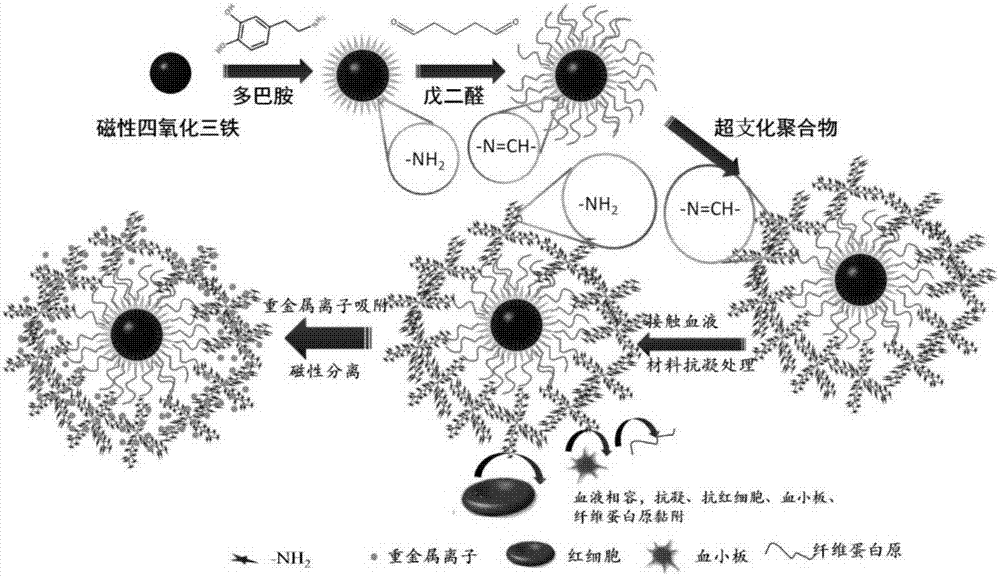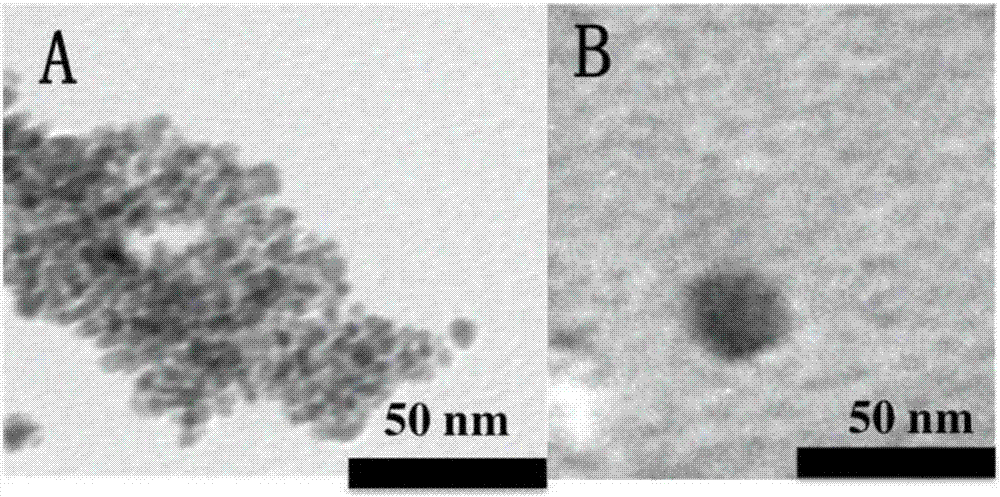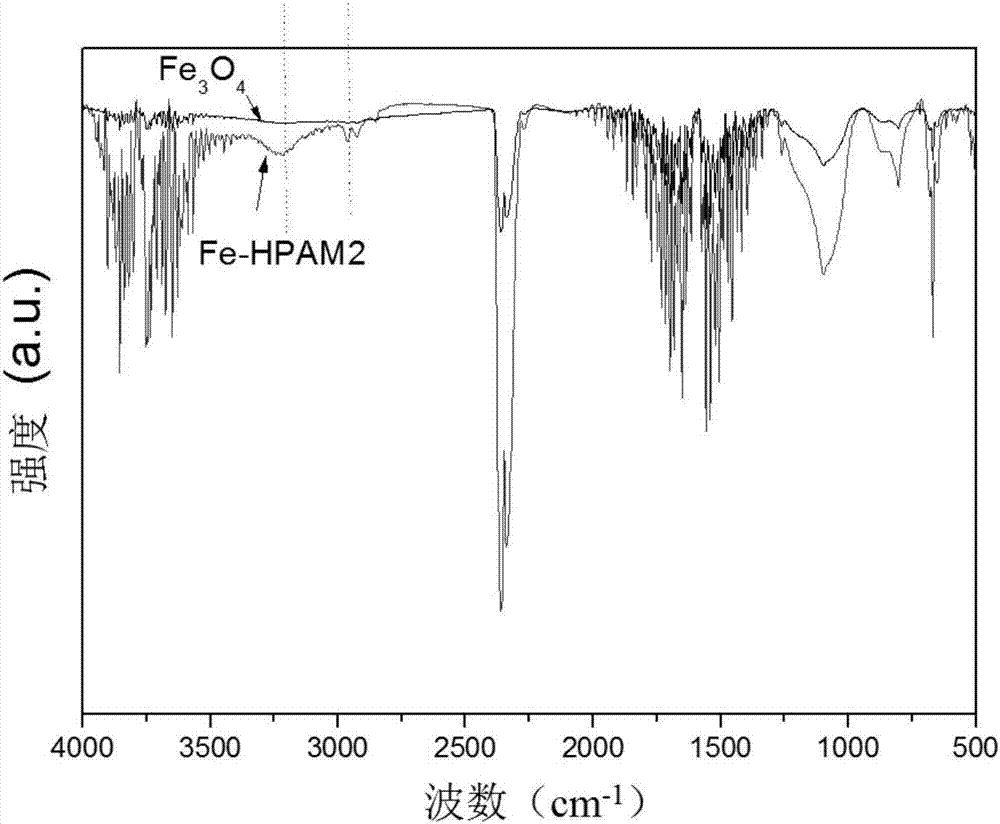Magnetic hyperbranched polymer or magnetic hyperbranched polymer derivative blood heavy metal ion adsorbent and preparation method and application thereof
A technology of hyperbranched polymers and heavy metal ions, which is applied in the field of biomedical materials and its preparation, can solve the problems of heavy metal ion adsorbents that cannot be directly applied and low ion concentration, avoid non-specific adsorption, simple process, and mild synthesis conditions Effect
- Summary
- Abstract
- Description
- Claims
- Application Information
AI Technical Summary
Problems solved by technology
Method used
Image
Examples
Embodiment 1
[0021] (1) Preparation of magnetic Fe3O4 nanoparticles
[0022] Weigh 3.4g of hexahydrate and ferric chloride and 1.5g of tetrahydrate and ferrous chloride, and dissolve them in 33.6ml of water to obtain a mixed aqueous solution of ferric chloride and ferrous chloride. Continuously feed N into the mixed aqueous solution of ferric chloride and ferrous chloride 2 After heating up to 25°C, quickly add 13.8ml of ammonia water (ammonia water 26%), stir vigorously, heat up to 80°C and continue to react for 1h, add 1.5g of oleic acid dropwise, and continue to react at 80°C for 1h. After naturally cooling to room temperature, magnetically separate, pour out the water, ultrasonically wash with ethanol and acetone, magnetically separate, collect the solid product, and vacuum dry at 70°C for 3 hours to obtain magnetic Fe3O4 nanoparticles. The transmission electron microscope picture of the obtained magnetic ferroferric oxide nanoparticles is as follows figure 2 As shown in A, by fig...
Embodiment 2
[0032] (1) Preparation of ferric oxide-dopamine nanoparticles
[0033] Prepare 10mg ml with the magnetic iron ferric oxide nanoparticles prepared in Example 1 step (1) -1 Magnetic ferric oxide-chloroform solution, take 5ml of the 10mg·ml -1 of ferric oxide-chloroform solution with 20ml25mg·ml -1 The dopamine Tris-HCl buffer solution was mixed and stirred, and reacted for 6 hours at a reaction temperature of 80° C. to obtain ferric oxide-dopamine nanoparticles.
[0034] (2) Modification of hyperbranched polymers
[0035] Disperse the ferric iron tetroxide-dopamine nanoparticles prepared in step (2) in water to prepare 10 mg ml -1 For the dispersion of ferric oxide-dopamine nanoparticles in water, take 5ml of the 10mg ml -1 The dispersion of ferriferric oxide-dopamine nanoparticles in water was mixed with 5 ml of glutaraldehyde aqueous solution with a mass fraction of 6% at room temperature, stirred and reacted for 12 hours, and the reaction temperature was 4°C. After the r...
Embodiment 3
[0037] (1) Preparation of ferric oxide-dopamine nanoparticles
[0038] Prepare 10mg ml with the magnetic iron ferric oxide nanoparticles prepared in Example 1 step (1) -1 Fe3O4-chloroform solution, take 5ml of the 10mg·ml -1 of ferric oxide-chloroform solution with 1ml 50mg·ml -1 The dopamine Tris-HCl buffer solution was mixed and stirred, and reacted for 6 hours at a reaction temperature of 60° C. to obtain ferric oxide-dopamine nanoparticles.
[0039] (2) Modification of hyperbranched polymers
[0040] Disperse the ferric iron tetroxide-dopamine nanoparticles prepared in step (2) in water to prepare 10 mg ml -1 For the dispersion of ferric oxide-dopamine nanoparticles in water, take 5ml of the 10mg ml -1 The dispersion of ferriferric oxide-dopamine nanoparticles in water was mixed with 5 ml of glutaraldehyde aqueous solution with a mass fraction of 6% at room temperature, stirred and reacted for 12 hours, and the reaction temperature was 50°C. After the reaction, adjust...
PUM
| Property | Measurement | Unit |
|---|---|---|
| Particle size | aaaaa | aaaaa |
| Particle size | aaaaa | aaaaa |
Abstract
Description
Claims
Application Information
 Login to View More
Login to View More - R&D
- Intellectual Property
- Life Sciences
- Materials
- Tech Scout
- Unparalleled Data Quality
- Higher Quality Content
- 60% Fewer Hallucinations
Browse by: Latest US Patents, China's latest patents, Technical Efficacy Thesaurus, Application Domain, Technology Topic, Popular Technical Reports.
© 2025 PatSnap. All rights reserved.Legal|Privacy policy|Modern Slavery Act Transparency Statement|Sitemap|About US| Contact US: help@patsnap.com



